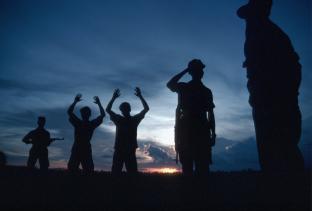
How should combatants be treated once they find themselves in the hands of the enemy? How do their “combatancy privilege and immunity” materialize, when in captivity? What can justify their internment as prisoners of war (POWs) and how long can this captivity last? Can they be tried for taking part in hostilities? What is the role of the ICRC in protecting and assisting POWs? What are National Information Bureaus (NIBs) and how do they relate to POWs? All these questions touch upon one of the fundamental protection regimes in international humanitarian law (IHL): the protection of POWs, which this highlight seeks to explore, drawing on the Combatants and POWs previous highlight.
Although POWs may not be prosecuted for their participation in hostilities, they may be interned until the end of active hostilities without almost any judicial or administrative procedure (Article 21, GC III). The purpose of this internment is not punitive, but only aims to prevent them from continued direct participation in hostilities. It also seeks to protect them, inter alia, from the dangers resulting from ongoing hostilities.
Once active hostilities have ceased, POWs must be released and repatriated without delay (Article 118, GC III). This obligation follows on logically from the primary justification for interning POWs, which is to prevent captured combatants from taking up arms again against the Detaining Power while hostilities are ongoing. Once these have ended, this justification no longer exists and captivity must end as soon as possible. The determination as to when active hostilities have ceased with a sufficient degree of stability and permanence to activate the obligation to release and repatriate has to be made in the prevailing circumstances of each case by looking at the facts on the ground. In the ICRC’s view active hostilities may be considered to have ceased when there is no reasonable expectation of their resumption (Updated Commentary to Article 118, GC III, para. 4455). It must be stressed that, even after the cessation of active hostilities, POWs remain protected under the Third Geneva Convention until they have been finally released and repatriated (Article 5, GC III).
- “Combatants and POWs”, in particular sub-section III: “Treatment of POWs”.
- “ICRC”, in particular sub-section II: “ICRC activities” and sub-section III: “Legal basis for ICRC action”.
- “Implementation mechanisms”, in particular sub-section IV: “Scrutiny by Protecting Powers and the ICRC”.
- United States Military Tribunal at Nuremberg, The Ministries Case
- United States, Former Prisoner of War on a Mission to Hanoi
- United States, Public Curiosity
- United States, United States v. Noriega
-
ICRC, Protection Policy (5.2. Activities to benefit persons deprived of their liberty)
- Combatants and POWs (thematic highlight)
-
Eight lesson course (see lesson 1).
-
Twenty lesson course (see lessons 2 and 14).
-
Year-long interdisciplinary seminar (see meeting no. 5)
-
A study of one armed conflict (see meeting no. 3)
-
- “Seminar centered on penal aspects” (see meeting no. 2 and suggested research topic 27).
- “Seminar centered on the substantive rules of international humanitarian law” (see meeting no. 5 and 12 and suggested research topics 19 and 22).
- The ICRC’s updated Commentary on the Third Geneva Convention, particularly:
- Article 9 on the ICRC’s right of initiative
- Article 13 on humane treatment of POWs
- Article 14 on respect for the person and honour of POWs
- Article 16 on equality of treatment and non-adverse distinction
- Article 21 on the internment of POWs
- Articles 29 on hygiene and 30 on medical attention
- Articles 71 on correspondence and 72 on relief shipments
- Article 123 on the role of the Central Tracing Agency
- Article 126 on the ICRC’s right to visit POWs
- Movie about activities of the ICRC for persons detained because of armed conflicts or situations of violence: ICRC, “In Detention – The humane way”, 2015 (18 min).
- The ICRC’s Humanitarian Law & Policy blog series dedicated to the updated Commentary on the Third Geneva Convention, in collaboration with EJIL! Talk and Just Security, particularly:
- POLICINSKI Ellen, “Prisoners of war in contemporary armed conflict: Interpreting the Third Geneva Convention 70+ years after its negotiation”, Humanitarian Law and Policy, 11 August 2022.
- Mahnad Ramin, “Shielding prisoners of war from public curiosity”, Humanitarian Law and Policy, 28 June 2022.
- ARMAN Jemma, “GC III Commentary: Protecting the honour of prisoners of war”, Humanitarian Law and Policy, 3 September 2020.
- COTTER Cédric, “The ICRC as a neutral intermediary: Historical and contemporary perspectives”, CROSS-Files, 2022.
- ARMAN Jemma, HENCKAERTS Jean-Marie, HIEMSTRA Heleen and KROTIUK Kvitoslava, “The updated ICRC Commentary on the Third Geneva Convention: A new tool to protect prisoners of war in the twenty-first century”, International Review of the Red Cross, Vol. 102, No. 913, 2021, pp. 389-416.
- CRAWFORD Emily, “Combatant status and prisoner of war protections”, in CRAWFORD Emily, The Treatment of Combatants and Insurgents under the Law of Armed Conflict, Oxford, OUP, 2010, pp. 48-77.
